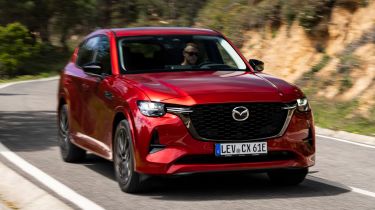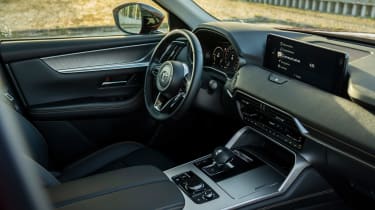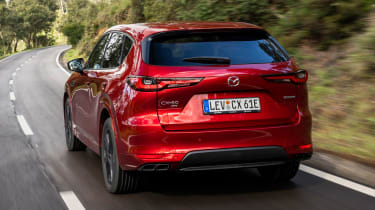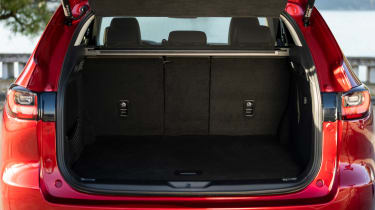Mazda CX-60 PHEV review
Mazda’s first plug-in hybrid features a high-quality cabin and plenty of standard kit to match German rivals, although less expensive alternatives from Hyundai and Kia are more efficient

Pros
- 12% company-car tax rate
- High-quality cabin
- Boot space
Cons
- Not as efficient as some rivals
- Interior packaging
- Engine noise
| Car type | Electric range | Fuel economy | CO2 emissions |
|---|---|---|---|
| Plug-in hybrid | 39 miles | 188mpg | 33g/km |
Mazda is a brand that likes to do things its own way, and now, after serving as a dependable rival to the likes of Ford and Honda for some time, the Japanese carmaker is looking upmarket. It’s set on becoming a genuine alternative to Audi, BMW and Mercedes by the end of the decade, and is kickstarting that transformation with the all-new CX-60 you see here.
The CX-60 is also Mazda’s first plug-in hybrid model – and an imposing one at that. Not just because it’s over four-and-a-half metres long, but also because it has a nearly three-metre wheelbase within that – a figure surpassing those of the Audi Q5 and BMW X3. With 323bhp and 500Nm of torque on tap, the plug-in CX-60 is the most powerful roadgoing car Mazda has ever made.
The CX-60 PHEV features the combination of a 2.5-litre four-cylinder petrol engine and 134bhp electric motor fed by a 17.8kWh battery, as well as an eight-speed automatic gearbox and all-wheel drive. Acceleration from 0-62mph takes just 5.8 seconds – which is a few tenths quicker than the plug-in hybrid BMW X3 – while top speed is 124mph.
Of course, efficiency is key when it comes to plug-in hybrids. Mazda claims the CX-60 can cover up to 39 miles on battery power, and reach 62mph in EV mode. As well as CO2 emissions of 33g/km, the CX-60 PHEV’s 188mpg fuel-economy figure is higher than those of the plug-in BMW X3 and Mercedes GLC, but falls short of cheaper alternatives from Kia, Ford and Hyundai. Fully recharging from flat takes four hours.
It’s not just the powertrain where Mazda is swinging for the premium entries in this class. The plug-in CX-60 starts at a whisker under £44,000 in Exclusive-Line trim, which includes 18-inch alloy wheels, LED headlights, a 12.3-inch central infotainment screen plus the same size of digital driver’s display, a head-up display, heated front seats and dual-zone climate control, plus front and rear parking sensors with a reversing camera. Wireless Apple and Android smartphone connectivity is included, too.
Stepping up to Homura spec for around £47,000 adds 20-inch alloys, a gloss-black finish on some body details, ambient cabin lighting, power adjustment and ventilation for the front seats, heated outer rear seats and a 12-speaker Bose sound system.
The range-topping Takumi model (just over £48,000) gets cosmetic upgrades only, with body-coloured wing mirrors, a gloss-black front grille, cloth detailing on the dashboard and white Nappa leather seat trim to match a white maplewood finish on the centre console.
There’s also a selection of option packs that feature everything from extra driver aids to a panoramic sunroof and a 150W AC socket. Try hard enough and it’s possible to nudge a CX-60 Takumi over the £50,000 mark – much closer to the starting price of BMW, Audi and Mercedes’ equivalent full-size PHEV SUVs. The Toyota RAV4 Plug-In and Hyundai Tucson Plug-In, on the other hand, are a little cheaper than the CX-60.
Regardless of the exact price tag, the CX-60 PHEV presents an appealing option for company-car drivers, who’ll be drawn to the electrified SUV because of its relatively low 12% Benefit-in-Kind (BiK) tax rate. That means even the top-spec Takumi model attracts a tax bill nearly half the size of the smaller CX-5 diesel in Sport trim.
It’s worth noting that the CX-60 we drove was a late pre-production model in Homura spec. But it still demonstrates how far Mazda is into its transformation, and how far it has to go. The CX-60 PHEV may be the most powerful model in Mazda’s arsenal, but it prefers a relaxed, patient approach over being hurried in any way. Around town, there’s more than enough poke from the electric motor for silent running, and if you’re gentle with the throttle you even may be surprised by how this continues onto faster roads.
But if you’re not, then the CX-60 has the shove to deliver swift progress, but you’ll be reminded, pretty quickly, that you have a four-cylinder engine under that long bonnet. The motor isn’t particularly harsh, but its appliance-like drone is hardly appealing, considering how audible it becomes in the cabin at higher revs – perhaps a little more so than the engines in the Mazda’s German benchmarks.
The new automatic transmission in the CX-60 isn’t the smoothest either, as there’s a bit of judder when it starts juggling the different power sources, or jumping between ratios. Again, a little patience will go a long way here. However, we were told to expect a few rattles and noises that’ll be dialled out by the time production begins – and the same could be said of the transmission’s calibration. So we’ll reserve final judgement on this until we drive a finished car in the UK.
When it comes to handling, the CX-60 feels keen to turn in, and more than happy to be thrown around when you encounter a twistier road. The body stays remarkably flat during quick changes of direction, helped by accurate, nicely weighted steering. The CX-60 even has the potential to be involving or even entertaining – more so than the Audi Q5 and Mercedes GLC in particular. There is a firm edge to the car’s ride due to the 20-inch rims fitted to our test model, but the suspension overall is compliant most of the time.
Even in our pre-production car, fit and finish were generally excellent. High-grade plastics are used in all of the key areas, there are sensible, solid-feeling physical switches for all of the key controls, and the digital screens look crisp and clear. The rotary controller for the infotainment is easy to use, too.
One of the neatest features up front is a driver personalisation system which takes your height and suggests ideal positions for the seat and steering wheel. It gets surprisingly close to the mark, but the more useful element is how it stores this setting based on facial recognition (you ‘record’ your face on a camera at the edge of the infotainment system). The car can then switch to the relevant profile the moment the driver gets into the vehicle, without them needing to press a button or delve into the car’s menus.
Unfortunately, some elements of the cabin’s packaging were a little more compromised than we’d like. The centre console, for example, feels extremely wide up front, making the footwells feel a little narrow. Then there’s the rear legroom, which is more generous than what’s on offer in the CX-5, but the gains aren’t quite as much as you’d expect given the overall stretch in length. There’s still room here for four six-footers, though, and even in a car with the optional panoramic roof fitted, we'd have no worries about headroom.
The boot is a useful size for a family SUV at 570 litres, or 1,726 if you fold down the second row of seats. There are handles at either side of the load bay to make lowering the back seats easier, although it’s disappointing that Mazda hasn’t fitted any bag hook to stop your groceries from sliding around the large floor. If you need something more practical, or space to carry more people, you’ll have to wait until Mazda launches the CX-80 in 2023.
The Mazda CX-60 is a dynamic SUV to drive, with a respectable amount of practicality and a high-quality cabin. While expensive in isolation, it’s competitively priced against the premium German PHEVs it rivals. Plus, its solid pure-electric range and 12% BiK rate should help Mazda’s new flagship find its way onto the shortlists of company-car drivers looking for a large SUV and a way to cut down on running costs.



